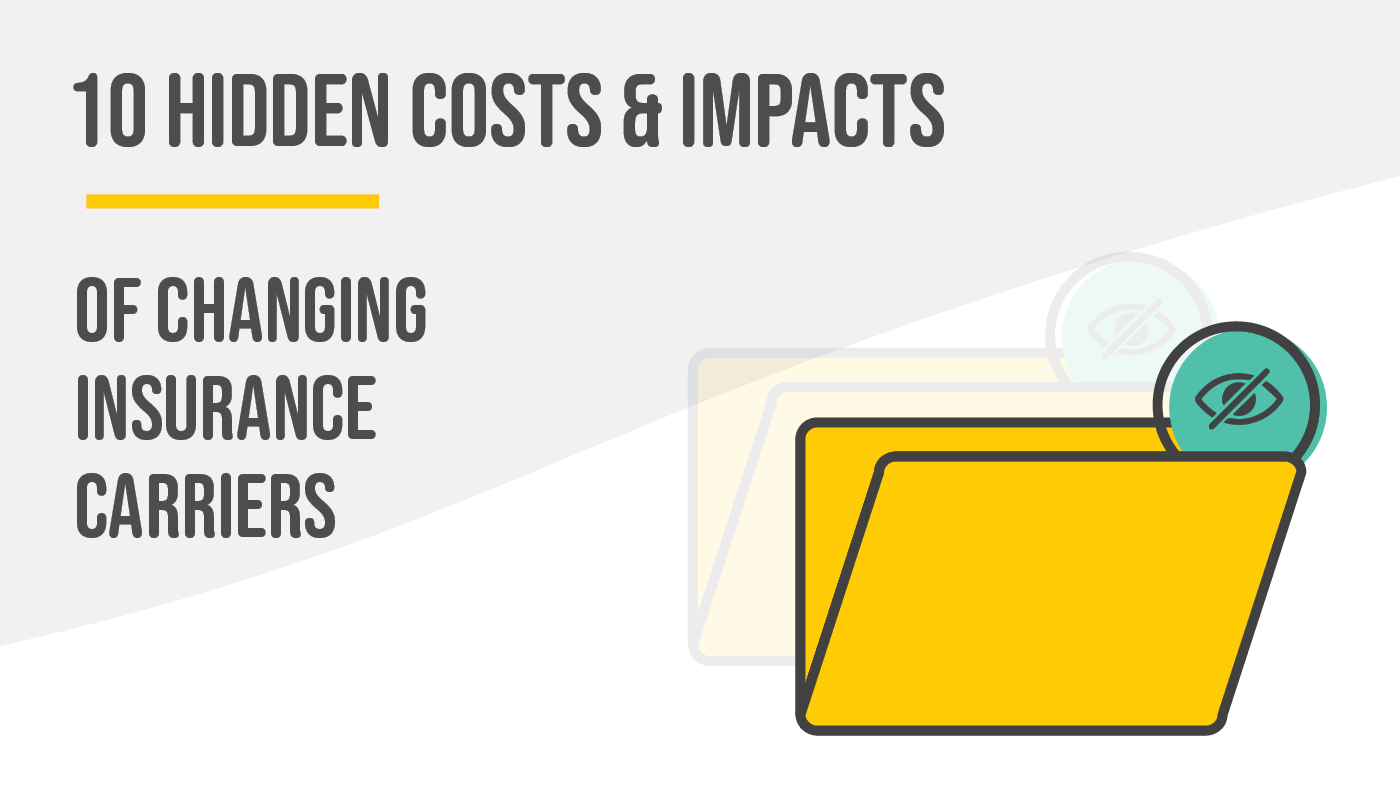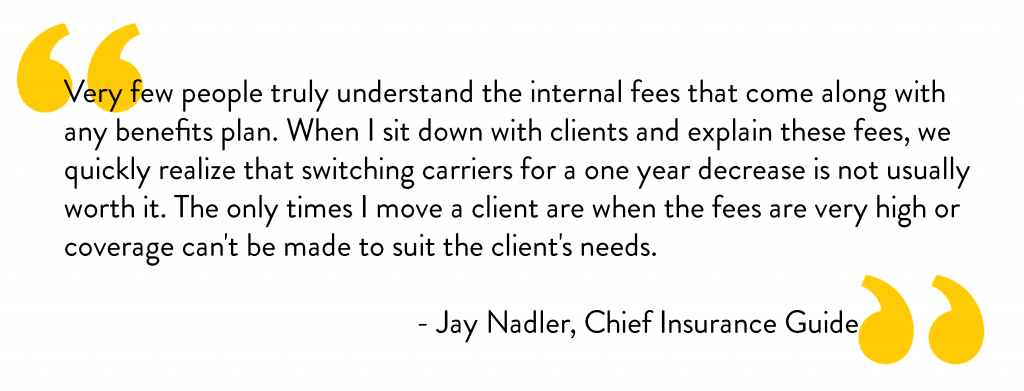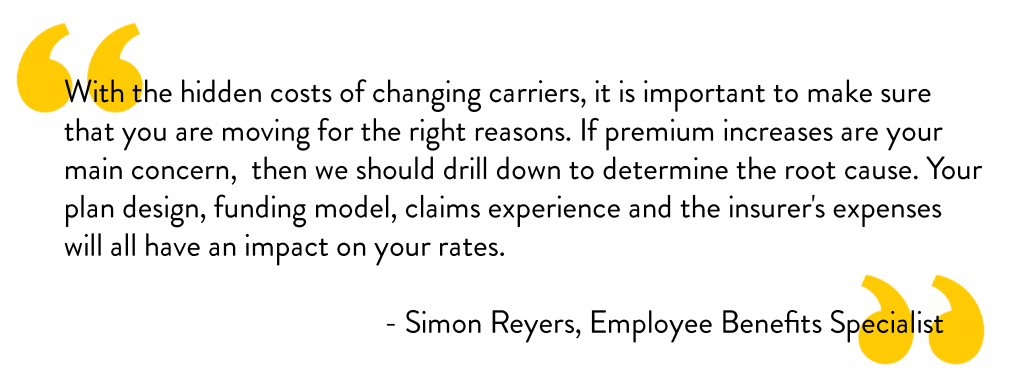10 Hidden Costs and Impacts of Changing Insurance Carriers
By: Benefits by Design | Tuesday August 18, 2020
Updated : Friday December 30, 2022
At Benefits by Design (BBD) Inc., we believe that a benefits plan should be sustainable over the long term. A sustainable group insurance plan grows with an organization. Sustainable plans are priced appropriately from the beginning, lessening the impacts of large increases at renewal.
Why Focusing on Employee Benefits Sustainability is the Best Shot at Success
Changing insurance carriers may be attractive for cost-savings but this might be temporary. There is a strong likelihood of an increase in rates at renewal, which is often more than the initial savings. What’s more, all of the time and effort involved in transitioning significantly cuts into the savings offered.
Before switching insurance carriers, consider these ten hidden costs and impacts:
The Costs of Time
Switching insurance carriers may seem like a quick and easy decision (particularly when there are cost-savings on the line). Still, there are significant costs with the amount of time and effort it will take to transition.
#1. Reviewing Options and Making Decisions Again
You’ll want to make sure you’re making the best decision for you and your employees by switching. To do that, you’ll need to carefully review all of the options with your group insurance Advisor. That takes a lot of time and energy that you could otherwise be putting into your business. Hasty decisions — or ones made without all of the facts — can be costly ones.
#2. Re-training Your Plan Administrators
With a new carrier comes new systems and processes that your Plan Administrators will need to learn. That’s time, money, and human capital spent on re-learning systems and processes rather than learning something new. Not to mention the potential this creates for miscommunication, confusion, and errors that further complicate the transition.
#3. Re-Enrolling Employees
With a new plan, your employees will all need to re-enroll. This can be a stressful process for employers and employees alike. It also invites the potential for employees to become late applicants. An employee’s coverage could be negatively impacted or even denied entirely if they’re not enrolled in time.
The re-enrollment process can be especially challenging where employees work in shifts because the window of opportunity to reach them for timely enrollment narrows.
#4. Communicating Changes to Employees
Employees will need to learn about their new plan and coverages in order for you to have an effective benefits plan. That benefits communication will fall to you. To communicate a new benefits plan effectively and avoid wasted effort and money takes time and consistent communication, so be sure you’re ready to go down that road.
For example, consider these necessary steps, which make up even the most basic communications plan:
- Announce the change in carrier
- Address specific questions
- Communicate re-enrollment and distribute materials
- Run an onboarding session
- Compile resources and information for distribution
- Address interruptions in coverage, changes in plan design, etc.
Benefits communication is among the most crucial (and most difficult to pull off) steps in a new benefits plan.
The Potential Risks
Switching insurance carriers invites several risks with significant costs attached to them.
#5. Carriers Can’t Match Existing Plan Design
Every carrier is different, and when you make a change, they may be unable to meet your current plan design. You might be all right with this, but it’s important to remember a very simple fact: employees probably won’t be.
Employees are happy when employers add new coverage to their benefits plan — that’s a no brainer. However, they also tend to get upset when they feel like they are losing coverage. That’s why our recommendation is always to start small and build from there — it’s far easier to add new coverage than it is to take it away.
#6. Certain Benefits and Expenses May be Ineligible
Not every carrier’s products cover the same things, particularly when it comes to medical items or drugs. So your Extended Health Care (EHC) benefit with your original carrier may cover some expenses that your new one will not, even though you’re not losing access to the benefit.
Other complications can arise. For instance, high-cost prescriptions generally need to go through the new carrier’s authorization process, leading to interruptions in coverage, confusion, and resistance from employees. Particularly if the end result is that the drug cannot be covered, as employees will naturally assume that their current coverage will remain the same, which is very often not the case.
#7. Disruption in Claims, Payments, and Authorizations
It is unlikely that there are no pending claims, payments, or authorizations left to process when a carrier change occurs. This means that your new carrier and your old one will have to coordinate as part of the transition, but as with many transitions, things often get lost or missed.
Important Note: Long Term Disability (LTD) Insurance
It is of particular importance to consider the consequences of switching carriers while there is a pending Long Term Disability (LTD) Insurance claim.
In most cases, employees must be actively at work to enroll in the new plan. Generally speaking, a new carrier will not want to take on the risk of an employee who is not actively at work. Employers who switch carriers with a pending LTD claim in place run the risk of that employee losing coverage, which then becomes a significant liability for the employer.
Losses You Can’t Take Back
When you switch carriers, you’ll experience some irreversible losses that can negatively impact you and your business.
#8. You’ll Lose Built-Up Reserves
Okay — bear with us here. Reserves are complex, but they’re an important part in answering the old Shakespearean question: to switch or not to switch?
Consider your reserves like a piggy bank. The money inside is used to cover the costs of Extended Health Care (EHC) and Dental Insurance claims submitted after a group terminates coverage. Employees can still submit claims for a period of time after termination, provided the claim was incurred while the plan was active. However, since the plan is terminated, the premium is no longer being collected, so the reserve fund is what pays the claims.
Every carrier calculates how much goes in the piggy bank differently, but once the amount is established at the first-year renewal, fluctuations and adjustments that might affect the reserve become easier to bear. When you switch carriers, you’ll need to re-establish that reserve fund, often resulting in an unfavourable first-year renewal, which greatly cuts into the “cost-savings” that made you switch in the first place.
#9. You Might Get a Bad Rap
Clients who frequently change insurance carriers may have a more difficult time obtaining quotes from new carriers. Not only because it puts up a red flag for the carriers that you’re a serial switcher, but it’s also often much more difficult to accurately predict claims history and experience, as it can be hard for the new Insurer to acquire experience from multiple carriers.
#10. The Underwriting Differs by Carrier
Underwriting is the process of determining the risk to the carrier in providing insurance to an employer. It’s a complex process with a variety of factors that go into consideration and each carrier will review these factors a little differently.
That means you want to ensure that certain switches don’t hurt your plan (or cost you more money) more than they help. If you are considering a switch, ask your Advisor to get more information on Target Loss Ratios (TLR)s, trend factors, and pooling charges.
Think Carefully Before Changing Insurance Carriers
Many carriers will strategically offer “savings” when you first sign up, but those reduced rates aren’t sustainable and you’ll likely be facing a large increase at renewal. When you add in the hidden risks and costs associated with making a switch, it becomes clear why plan sustainability is so important to us at BBD.
To maintain sustainable coverage over the long term and ultimately save employers money, time, and energy in the long run, we put plan sustainability at the forefront.
Back to Top




